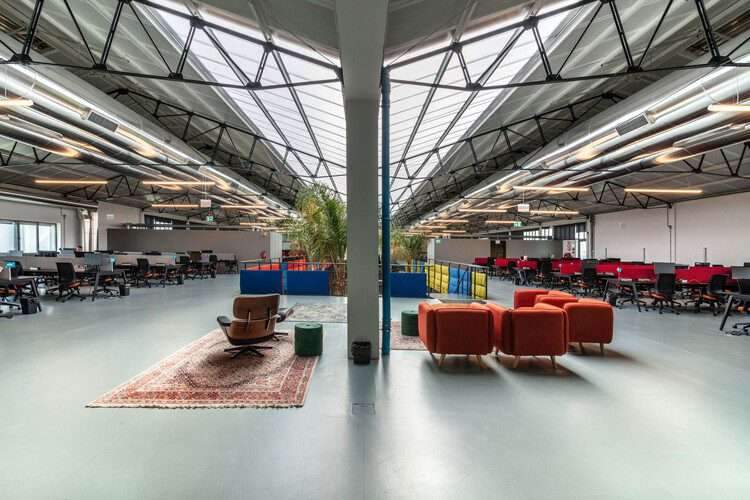Meet project 821, the world’s first hydrogen fuel-cell superyacht
Yacht builder Feadship recently unveiled what may be the world’s first hydrogen fuel-cell superyacht, Project 821. It is a colossal water vehicle with a size of 118.80 meters, all running on hydrogen, which is a lightweight, ‘puffy’ substance. When hydrogen is processed in a fuel cell, the by-products are electricity and water in the form of steam.
For a superyacht, it may be able to carry a lot of power without adding too much weight. The only catch, one that the Feadship team had to confront, was that hydrogen needs to be stored in an extremely cold container to keep it from taking up too much space as a gas. To do this, Feadship had to make Project 821 a bit longer than originally planned to fit a four-meter storage tank, hence its 118.80-meter size.
images courtesy of Feadship
Feadship creates custom four-meter hydrogen storage tank
Feadship’s custom four-meter storage tank takes up quite a lot of space, eight to ten times more than regular diesel fuel would, even though the hydrogen itself is lighter. On the upside, the fuel cells on the Project 821 superyacht can also run on methanol, which is a liquid fuel that’s easier to store, a cleaner version of gasoline.
Methanol doesn’t need to be super cold, so it might take up less space on the superyacht. At the moment, future innovations on fuel cells and onboard reforming of methanol to hydrogen are on the near horizon for Feadship, who’s focusing more on the current hydrogen technology they have in front of them.
the superyacht is a colossal hydrogen-run water vehicle with a size of 118.80 meters
In terms of energy storage, superyacht Project 821 stores less energy, around 543 kW hours, compared to a similar-sized yacht of Feadship named Savannah, which uses diesel (1 megawatt hour). The new superyacht doesn’t need as much stored energy since its hydrogen fuel cells can continuously generate power while it is running.
Think of it as having a refillable generator onboard, boosting the superyacht’s power instead of relying only on a battery.In this way, the hydrogen-run Project 821 eliminates noisy engines when anchored or traveling slowly, and there’s no pollution when it cruises either.
yacht builder Feadship recently unveiled what may be the world’s first hydrogen fuel-cell superyacht
superyacht Project 821 and its heat recycling system
The superyacht Project 821 also has its own heat recycling system, which captures the waste heat from the engine—in this case, the fuel cells—and uses it for heating the pool, jacuzzi, and steam room on board, keeping the air at a moderate temperature in the guest areas, warming the towel bars and bathroom floors, and curtails the use of separate heaters to power up these amenities.
Feadship also installs a smart air conditioning system which automatically adjusts its temperature based on occupancy so that if nobody’s in a room, it won’t waste energy cooling it. The British RWD Studio worked on the entire look of the hydrogen-run Project 821, including the exterior, general arrangement, and all the décor inside.
the superyacht Project 821 also has a heat recycling system, which captures the waste heat from the fuel cells
Coastal vibe is the theme the design attempts to evoke, the feeling of being near the beach or ocean while in a state of luxury. Light and airy colors and interior furnishings may help bring these up, starting with the use of light colors like white, beige, and cream for the walls, furniture, and fabrics. This sense of openness and bigger space is accompanied by textured fabrics and leathers, as well as a variety of natural materials.
These include marble, rattan, eucalyptus wood, and limed oak, a light-colored wood, all of which run throughout the interior of the superyacht Project 821. The design firm also retained the shapes of certain design elements on different floors, such as door trim features and hallway railings, to create a sense of continuity, but their use of materials vary, so that the guests can have the feeling of being in a new area.
the hydrogen-run superyacht is designed for families, with the top deck resembling a whole apartment on its own
The hydrogen-run superyacht is designed for families, with the top deck resembling a whole apartment on its own. It has two bedrooms with separate bathrooms and closets, a gym,a pantry, two offices, each with a fireplace for working or relaxing, and a living room. There’s a walkaround deck with shaded areas at the front and back for lounging and enjoying the outdoors, and a jacuzzi in the front for a scenic soak.
Since Project 821 is wide, the hallways inside the superyacht are spacious to make walking around easy, allowing large side decks outside as well where guests can walk side-by-side. The superyacht has a private access point for the owners that goes all the way down to the lower deck, which features a staircase with built-in bookshelves and display areas and an elevator for easy access between decks.
Feadship’s Project 821 uses light and airy colors for the interior
On each floor, dedicated areas await guests, such as a coffee corner and a games area on the bridge deck, a library on the main deck, and a private dining room with a balcony and a connected bedroom on the lower deck. Feadship says Project 821 is the biggest superyacht ever built in the Netherlands, beating out its own sibling, Launchpad.
Even though they’re similar in length, Project 821 has 30 percent more space inside and has five floors above the water and two floors below, with the owner’s deck being as high as a 12-story building. As of publishing the story, Project 821 is being offered for sale by Edmiston.





